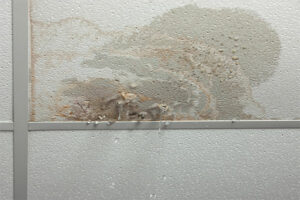Repairing A Water-Damaged Ceiling
 Water damage cases are always considered to be emergencies that require swift attention, regardless of the water’s source. All the materials in your home absorb this excess water, including drywall, furniture, subflooring, support structure, etc. Water absorbed by these materials can cause water damage to spread to more areas of your home, making the damage worse than when it began. Even worse, lingering water damage in your home can lead to structural damage and mold growth.
Water damage cases are always considered to be emergencies that require swift attention, regardless of the water’s source. All the materials in your home absorb this excess water, including drywall, furniture, subflooring, support structure, etc. Water absorbed by these materials can cause water damage to spread to more areas of your home, making the damage worse than when it began. Even worse, lingering water damage in your home can lead to structural damage and mold growth.
Water Damage Cleanup - Savannah
The ceiling of your home is a very common place for water damage to occur. Plumbing issues or a leaking roof are the typical reasons your ceiling is sustaining water damage. No matter the reason, it is critical to repair it right away. The longer it is ignored, the more complex the water damage cleanup will be. If you find that your ceiling is water damaged, take the following steps to minimize the problems you could face.
Stop The Water Source
In any water damage situation, the first step you will need to take before starting any repairs is to stop the water at the source. Repairs done before stopping the water source will be completely useless, as the water damage will come right back. To locate the source, you may have to cut behind drywall to find the problem. Unfortunately, water damage spreads quickly, so the source could be far away from the visual damage.
Dry Water Damaged Areas
Once you have stopped the water source, you can begin to dry the ceiling. Place down a tarp to protect the floor, furniture, or anything in the surrounding area from the dripping water. You can then use towels, fans, or anything you can find that will help you dry the affected areas. If you are still experiencing dripping water even after you have thoroughly dried wet areas, that means that the ceiling is still very saturated and may need to be cut out to dry the area further. Any drywall that is bulging can be punctured. Just be sure to place down a bucket to catch any water.
Remove Damaged Sections
If you find any areas of the water-damaged ceiling that are peeling or bulging, scrape these parts off. Other damages, such as water-stained sections, will also need to be removed. If you find that the drywall has stains but no structural damage, you can save it by cutting out only the problem areas. Use a keyhole saw to cut out the damaged section into the shape of a rectangle or square. Then you can easily replace the part with a drywall patch later.
Repair
After removing damaged parts of the ceiling, you will need to smooth down any ridges, bumps, or rough areas with sandpaper. Small holes can be filled with joint compound, then, after being dried, can be sanded down as well. New drywall pieces will need to be fitted in for any sections that have been completely cut out. Use adhesive to attach new pieces, then layer on the joint compound and sand to match the rest of your ceiling. Once all of these repairs are finished, you can complete the job by priming and painting the ceiling. Try to repaint the ceiling with paint similar to one that is already there to blend everything seamlessly.
When To Call For Professionals
It’s important to know when to call a professional. Though there are steps that can be done on your own, some things are better left to professionals. If any project seems difficult or uncomfortable to undertake, a licensed professional can help out, such as Harper Special Services. Keeping your home water damage free is essential, especially when done correctly and safely. You do not have to undergo water damage cleanup on your own. Reach out for help today!
Recent Posts
-
Maximizing Efficiency in General Contracting: Top 6 Project Management Tools You Need to Know
August 15, 2025
-
Is Modular Construction the Future? Pros and Cons for General Contractors
August 01, 2025
-
From Disaster to Recovery: A Step-by-Step Guide for Consumers Facing Water or Fire Damage
July 15, 2025